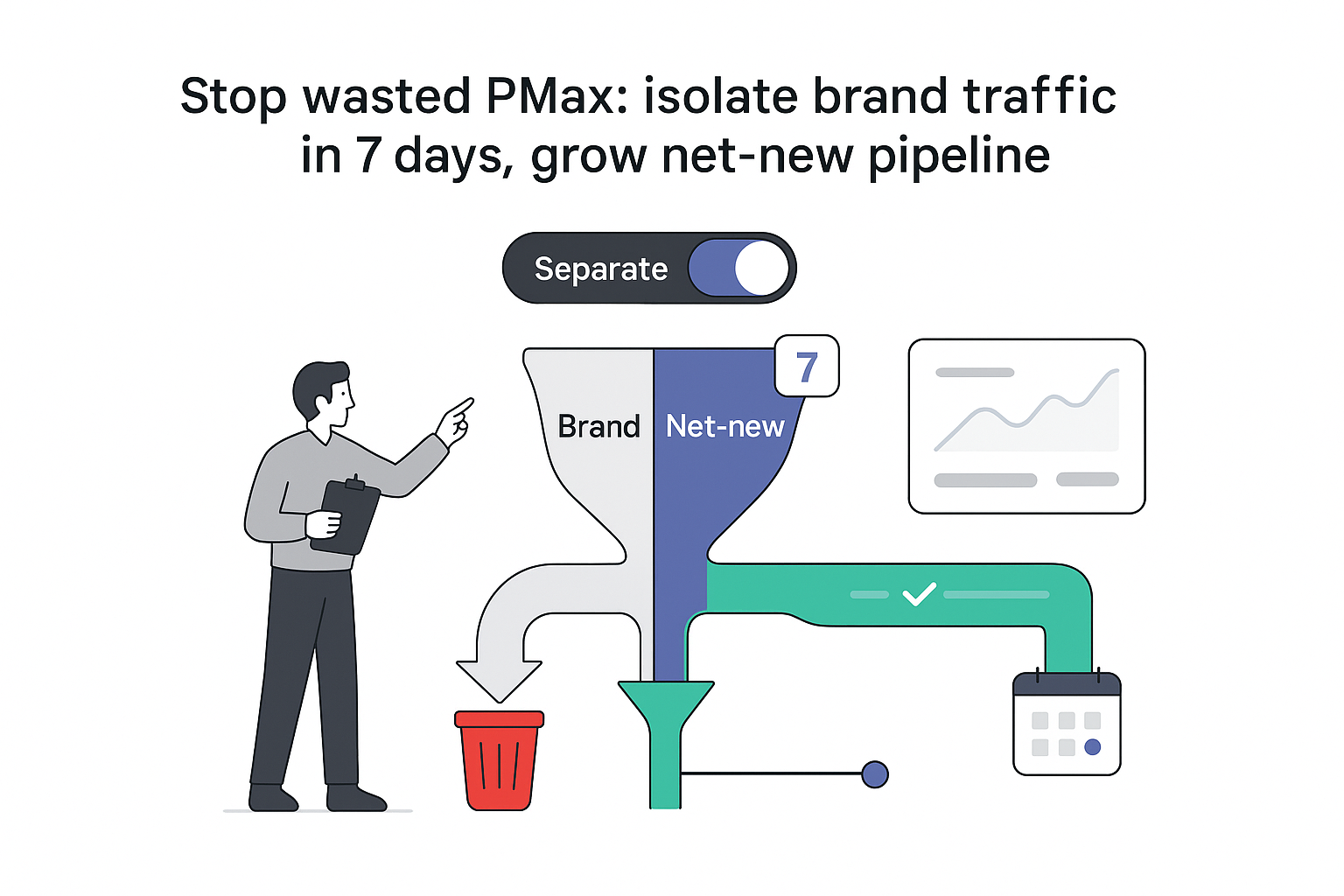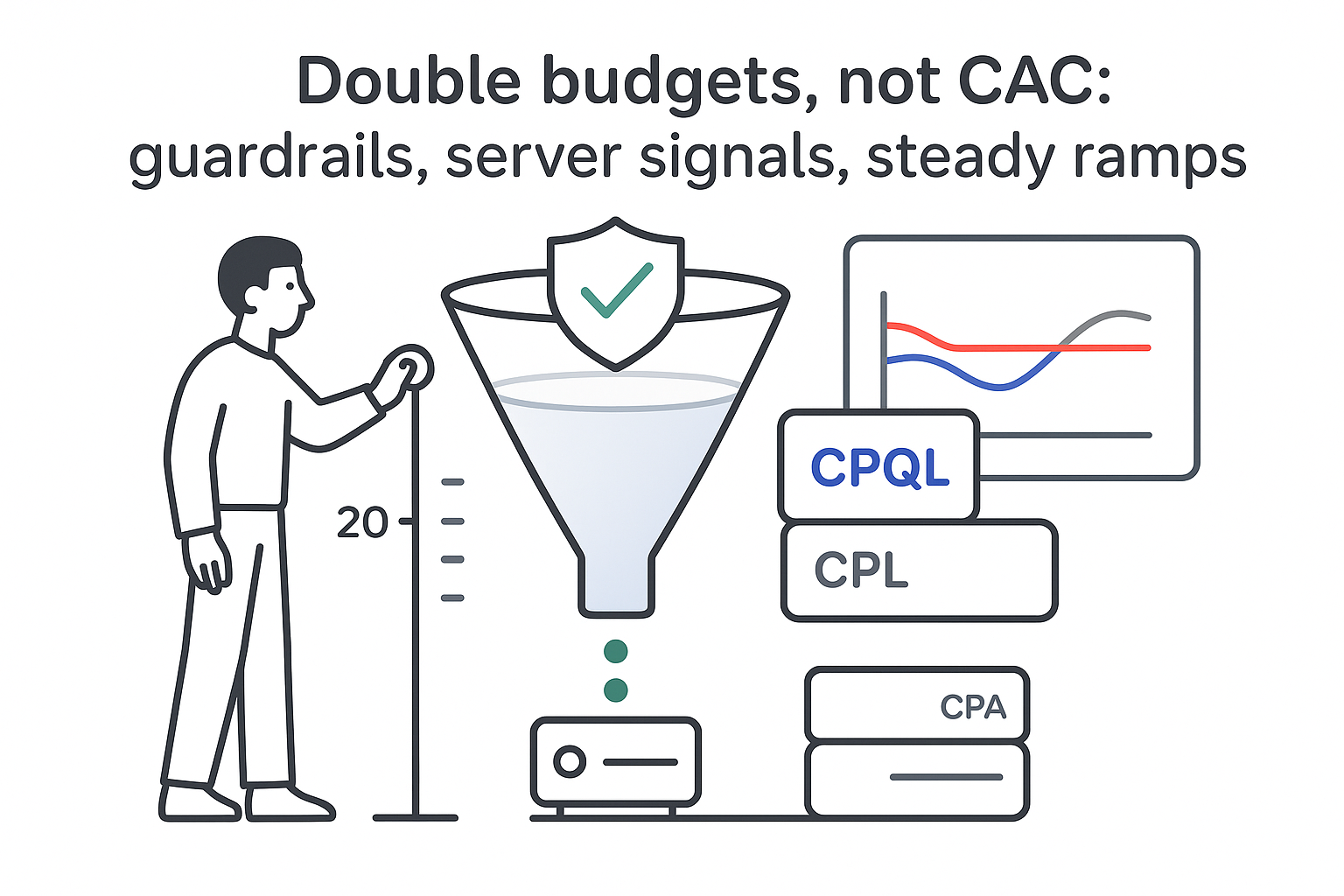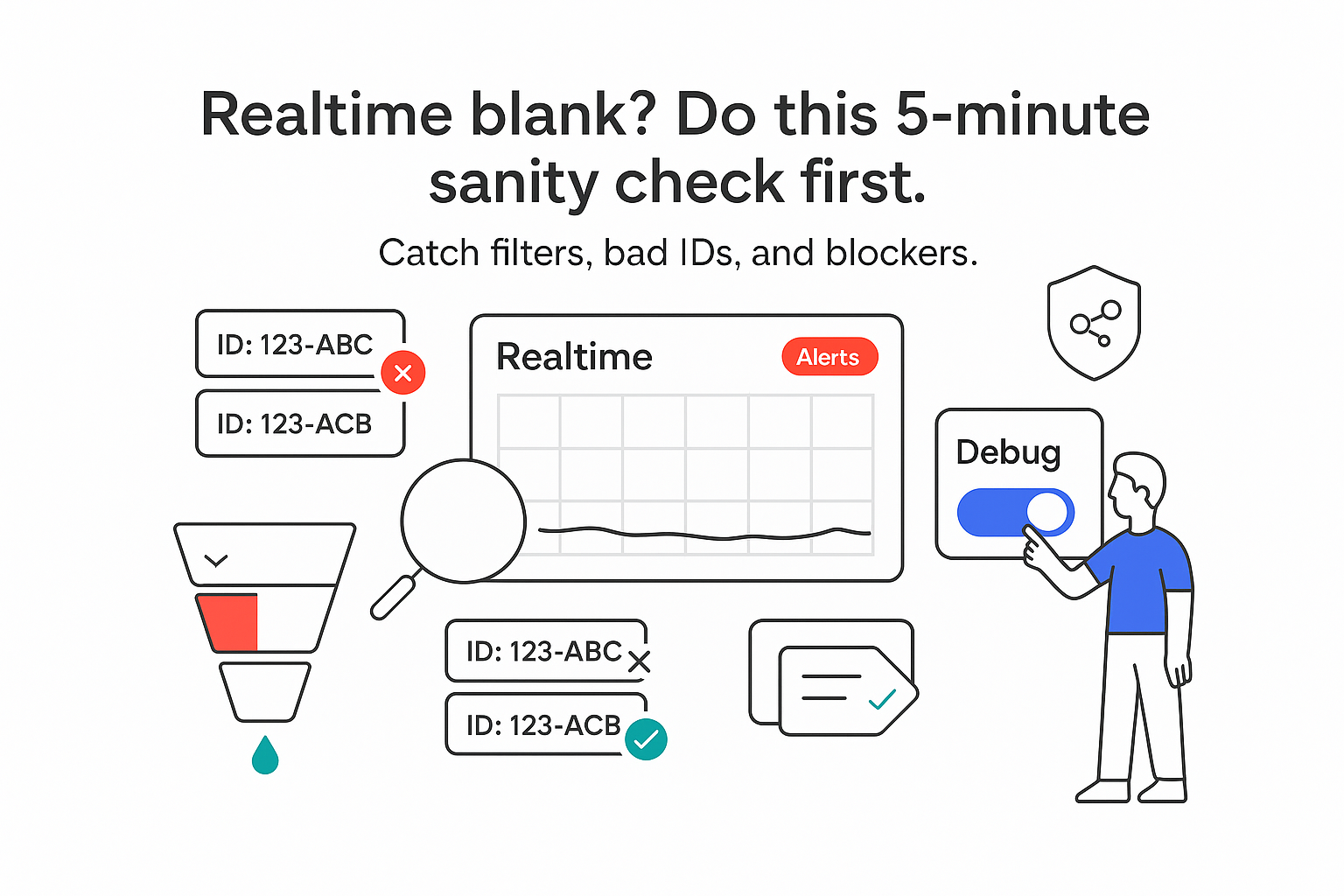Why Performance Max feels paradoxical in B2B
If I run a B2B service business and care about pipeline more than pretty charts, Performance Max can feel like a paradox. It promises reach across Google Ads inventory - and it can deliver. It can also swallow budget, blur attribution, and make brand metrics look fantastic while prospecting lags. That tension is fixable. With a clear structure, tight definitions of qualified outcomes, and a few sanity checks, I can get real signal without babysitting.
Quick signals I use to spot wasted spend
I don’t start with a long audit. I start with proof.
- Search term insights: In Google Ads > Performance Max > Insights > Search categories, I scan how many conversions map to my brand, product names, or direct URL searches. If roughly a third or more of conversions look branded, prospecting is likely weak. That’s a heuristic, not a law - industry mix matters - but it’s a fast tell.
- Predefined reports: Reports > Predefined > Performance Max lets me break down asset groups, networks, and placements. I compare CPA or CPL by network. If Display and Discover quietly hoard spend with soft conversions while my goal is qualified demos, I’ve got a problem.
- Brand vs non-brand split: I create a custom brand segment across the account and compare conversion share and CPA/CPL between brand and non-brand, including Performance Max. I include sales-relevant metrics like MQL-to-SQL rate to avoid celebrating form fills that go nowhere.
- New vs Returning: In the campaign view, I add the New vs Returning segment. If a large share of conversions are returning users on brand or direct paths, Performance Max is likely intercepting demand I already had rather than creating new demand.
- Query intent proxy: In Insights, the intent buckets act as a rough proxy for query type. Heavily branded categories with high conversion volume point to cannibalization.
What I capture for my records:
- Campaign view with New vs Returning segment and conversion columns visible.
- Insights with Search categories sorted by conversions and conversion value.
- Attribution > Conversion paths showing common paths that include Performance Max touches before a brand search.
A 7-day brand separation test I trust:
- Day 0: I pull baseline metrics for qualified demos, SQOs, and pipeline credited to Performance Max. I include lagging indicators from my CRM for the prior 30 days.
- Day 1: I exclude brand terms from Performance Max using account-level negatives or a dedicated negative list. If Final URL expansion is on, I turn it off for brand pages or exclude those URLs.
- Days 1–7: I monitor daily. A conversion drop is expected - that’s the point. I watch new customer rate, assisted conversions, and non-brand search volume.
- Day 8: I compare non-brand conversions and qualified outcomes to the prior period. If total pipeline holds or improves while brand moves to my Search brand campaign at a lower CPA, my account just got cleaner.
For B2B, I score by qualified demos, SQOs, and opportunity value. I track those in my CRM and feed them back into Google Ads as offline conversions. If Performance Max sustains those outcomes with brand excluded, I’m in business.
How I keep brand search separate and under control
Brand should live outside Performance Max so I can control bids, pages, and spend. A clean, conflict-free structure keeps me sane.
- Campaign lanes
- Search - Brand Exact
- Search - Brand Phrase
- Search - Competitor Defense (optional and careful)
- Search - Non-Brand Core
- Performance Max - Prospecting Only
- Naming that scales
- Prefix by channel and intent, for example: SEA_Brand_Exact_US, PMax_Prospecting_US.
- Add country/region and device if I split by device.
- Bidding and budgets
- Brand Exact: Target impression share around 90–95 on my brand. Keep CPCs low. Manual CPC is fine if I want extra control.
- Brand Phrase: Lower budget than exact, with tight negatives to block generic queries I don’t want.
- Non-Brand Core: If tagging is stable and volume is sufficient, I use tCPA or tROAS. Otherwise I start manual while I collect clean data.
- Performance Max - Prospecting Only: I set a separate budget I can scale based on incremental pipeline, not just CPL. I start smaller than brand and grow with proof.
- Exclusions that protect brand
- I add account-level negative keywords for brand terms and product names to Performance Max. If native options are missing, I request a Performance Max negative list from support here.
- I limit Final URL expansion or turn it off for brand/pricing pages if I see brand-weighted conversions bleeding into Performance Max.
- I use brand exclusions in Performance Max. They’re imperfect but helpful, and Google’s position is that brand terms in PMax are incremental - which I validate with tests.
- B2B nuance that matters
- SLA-backed lead definitions: I only count a lead when it passes my agreed checklist with sales. If my CRM flags MQL or SQL, I map that status back as an offline conversion.
- Call tracking: I tag qualified calls and push them back into Google Ads so bidding learns from real conversations, not just forms.
- CRM feedback loops: I connect my CRM with Offline Conversion Imports so Performance Max learns from SQOs, pipeline, and closed-won value - not vanity metrics. See Google’s guide to offline conversion imports and consider value rules if I need to weight outcomes.
I picture clean lanes: brand campaigns on the left feeding low-cost, high-control conversions; Performance Max on the right chasing net-new demand; non-brand search in the middle filling the gap.
Attribution that doesn’t flatter brand
Performance Max runs across YouTube, Display, Search, Discover, Gmail, and Maps. That reach is great, but it can inflate assists and make results look better than they are if brand is mixed in. My fix is fair measurement.
- Models I compare
- Data-driven: Uses my data to distribute credit. In brand-heavy paths, it can still overweight brand touches late in the journey.
- Position-based: Weights first and last touches. It highlights top-of-funnel contributions but can still favor brand last-clicks.
- Where I look
- Model comparison: In Google Ads or GA4, I compare Data-driven with Position-based and Last click. If Performance Max swings wildly between models, brand is doing more lifting than I’d like.
- Path length: In Attribution > Conversion paths, I inspect average touchpoints before conversion. Short paths ending in brand searches suggest Performance Max is assisting more than converting.
- Segments I build for clarity
- Brand funnel: brand queries, direct traffic, exact brand match. This is my control.
- Non-brand funnel: generic solution searches, category terms, competitor research.
- Net-new customers: new users or new CRM customer IDs within the last 90 days.
I compare CPA, SQO rate, and pipeline per segment. If Performance Max drives non-brand and net-new at acceptable costs, I keep leaning in. If wins cluster in brand, I tighten structure and inputs.
Incrementality check for brand:
- Geo holdout: I pick similar regions based on brand volume and sales mix. I pause brand campaigns in the test region for 2–4 weeks, keep Performance Max brand exclusions in place, then compare net-new customers, total revenue, and blended CAC.
- If geo isn’t clean, an audience split can work, but geo tends to be clearer. Third-party tests often show modest or zero lift from brand search. See example results.
I choose KPIs sales respects: net-new customers, blended CAC, pipeline value, and SQL volume. For many B2B firms, brand provides protection and routing control, yet its incremental lift can be modest. That doesn’t mean I cut it; it means I price it right and keep it in its lane.
Useful references for mechanics:
When I use Performance Max for B2B
Performance Max is a goal-based campaign that taps all of Google’s ad inventory from a single setup. It pairs my conversion goals with bidding and creative, then adjusts in real time.
When it shines:
- I have enough conversion volume and clean tagging, including enhanced conversions and offline imports.
- I have strong creative or a quality product feed and can keep assets fresh.
- I have first-party audiences like customer lists and high-LTV cohorts.
- I want to find new customers across channels, not just harvest brand demand.
B2B situations where it fits:
- Lead gen with CRM feedback, so Google learns from SQOs and revenue.
- Long sales cycles where video and display can warm up accounts before search.
- Regions where Search alone can’t scale because query volume is low.
When to go slow:
- Weak conversion signals or broken tags. Garbage in confuses bidding.
- One landing page for everything with no message match by segment.
- Heavy reliance on brand that flatters numbers without new pipeline.
I proceed if:
- I can measure qualified demos and SQLs in-platform via offline imports.
- I’m driving several non-brand conversions per day.
- I can segment asset groups by intent or industry and feed specific creative.
I avoid or limit it if:
- I can’t separate brand from prospecting.
- I lack high-quality assets and can’t add them quickly.
- Sales can’t return lead quality signals within a week.
The inputs that raise the ceiling
Performance Max uses Google AI to pick audiences, placements, bids, and creative combinations. I treat it like a very fast assistant that still needs clear instructions.
- Audience signals
- First-party lists: customer match, high-LTV segments, churn-risk lists I want to re-engage, and lookalike seeds.
- In-market and custom segments: I build from my most valuable keywords and URLs and keep themes tight.
- Exclusions: I exclude current customers if the goal is net-new logos.
- Creative variety
- Text: short, specific headlines that promise outcomes buyers care about, in my ICP’s language. For auto-generated text options, see About text customization in Performance Max campaigns.
- Images: real team photos, product-in-action visuals, simple diagrams. I avoid generic stock when I can.
- Video: short explainer clips (15–30s). Auto-generated can fill gaps, but handmade usually wins. Reference video assets for Performance Max.
- Extensions and routing
- Sitelinks that map to high-intent subpages like pricing, case studies, or industry solutions.
- For higher ACV, I route to focused landing pages with proof and qualification fields.
- Conversion tagging
- Enhanced conversions for web so modeled data can fill gaps.
- Offline imports from CRM for SQOs and Closed-Won with values.
- Consent Mode v2 if I operate in regulated regions.
- Governance that keeps it honest
- I exclude low-value URLs and knowledge-base pages. I limit or disable Final URL expansion if it pulls unhelpful pages.
- I add account-level negatives for my brand in Performance Max.
- I set account-level brand safety to avoid placements I don’t want.
Asset groups that actually work for B2B service firms
I make asset groups specific. Fewer, tighter groups beat a giant bucket that tries to do everything.
Patterns that reliably work:
- By intent
- High-intent solutions: mirror my non-brand search themes.
- Competitor curiosity: respectful, benefit-led messaging around switching triggers.
- By ICP vertical
- One group per industry (e.g., finance, healthcare, SaaS, manufacturing) with industry-specific proof points.
- By pain point
- Efficiency, compliance, revenue acceleration. Each maps to a matching landing page.
Copy blocks I keep handy:
- Headlines lead with outcomes: “Cut onboarding time in half,” “Replace vanity metrics with pipeline wins,” “Close deals faster with cleaner data.”
- Descriptions: 1–2 crisp benefits, 1 credibility proof, a soft qualifier. Tight beats clever.
Creative specs that prevent rework:
- Images: at least 1200×1200 (square) and 1200×628 (landscape), including one text-light option.
- Video: 16:9 and 1:1 cuts with a clear hook in the first three seconds.
Operational must-haves:
- Landing page routing that matches each asset group’s theme.
- UTMs with campaign, asset group, and audience signal so CRM analysis is simple.
- RSA parity: I reuse high-performing Search headlines where relevant.
- Policy checks on brand names, claims, and regulated content before launch.
Pulling it all together
Yes, Performance Max can waste spend when brand lives inside it. It can also find prospecting wins that Search alone can’t reach. The difference is structure, clean inputs, and a scoreboard my sales team trusts. I keep brand in its lane, measure with care, and feed Google AI the signals that match how my pipeline actually grows. When that happens, I stop arguing with dashboards and start hearing the only metric that matters in B2B: “We’re seeing better deals come in, and more of them.”







.svg)